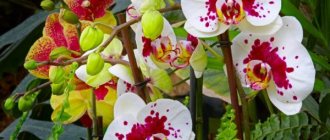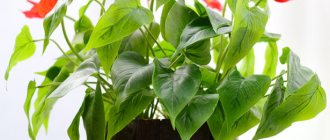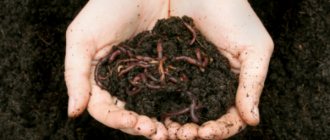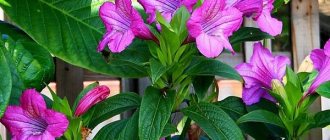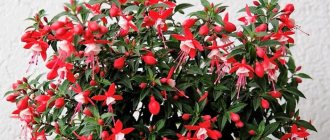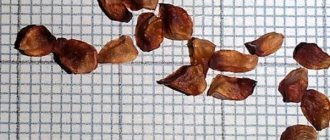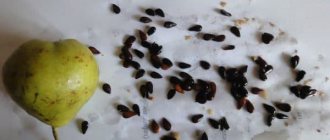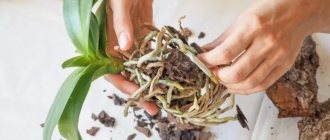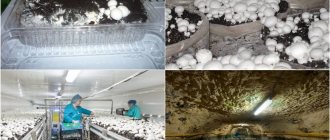What is it used for?
Attention : When growing orchids, moss can be used as an independent substrate or a useful additive.
Main purposes of application:
Increase in humidity . Using moss as a covering layer, the substrate will be constantly moist without increasing watering.- Getting kids . If you place a peduncle cut and treated with cytokinin paste in a container with damp moss, over time a shoot will appear from the “dormant” bud.
- Raising children . Cut sprouts are placed in clean moss or a mixture of moss and bark.
- Saving a dying plant . An orchid with rotten roots should be planted in a moss substrate and greenhouse conditions should be created.
- Engraftment of roots to the block . To secure the roots to the block, you need to put moss under them. After six months, algae will begin to grow, a sediment of salts will appear, the moss will begin to crumble, but the orchid will already be tightly attached to the block.
- Preventing drying of young roots that appear above the soil . To do this, the soil surface must be covered with moss. The amount of moss depends on the number of holes in the flowerpot.
With proper use of moss, orchids will thank the grower with stable growth and lush flowering.
Functions in gardening
In addition to the fact that moss is one of the components for orchid soil, and is also used in folk medicine, it has other “merits”.
- The plant can be a drainage plant.
- Sphagnum moss is used to make bedding for flowerpots.
- Moss covers the soil mixture.
- The bulbous plants are covered with the crop so that they do not freeze in winter.
- Sphagnum is wrapped around the rhizomes to retain moisture.
- Used to combat fungal diseases.
One cannot argue with the fact that moss is simply necessary for orchids, both when planting a flower and fighting diseases.
Sphagnum moss grows in coniferous forests, in slightly swampy soils, in swamps, overgrown oxbow lakes of rivers, an especially large mass is formed in raised bogs, where it covers the entire surface like a pillow, and from a distance looks like a carpet. Moss consists of soft thin stems with needle-shaped soft leaves sticking out in all directions and contains a lot of water in the cells of the dead part of the plants. The moss comes out easily. Used as a substrate.
Forest moss, (cuckoo flax), grows in clearings, around tree trunks, often next to or interspersed with sphagnum in large areas. . When dry, it does not crumble, the upper part is green, the lower part is brown. Moisture, unlike sphagnum, does not stay in it for long. Really looks like a juniper branch. Can reach 20cm in good humid summers. Pests are easily visible and removed. It can also be used either as a substrate or added to the main substrate. Very convenient for blockers and equirants.
| Description | Advantages and disadvantages | |
| Sphagnum moss (sphagnum) | A genus that includes several species of bog moss that do not have rhizoids (“roots”). Consists of repeatedly dissected succulent stems with sessile ligulate leaves. It is found in swamps, where it covers hummocks with a loose green mat or floats freely on the surface of the water. | It has very high hygroscopicity, absorbing water over the entire surface with the help of special water-storing cells. Contains an antiseptic (carbolic acid) that kills pathogenic flora. Disadvantages – it acidifies the substrate, when crushed it strongly cakes and becomes compacted. |
| Forest moss (mnium, climatium, ptilium, etc.) | Different types of leaf-stemmed mosses, independently collected by flower growers in the forest. They are used live, collected together with rhizoids. | They create a living, moderately humid environment around orchids if they are placed on top of the substrate. The stems do not become compacted and retain good air permeability. Ideal for cuttings and growing babies in clean moss. Disadvantages: live moss requires careful preliminary preparation; when mixed with bark, it quickly dies and loses its benefits. |
| Kukushkin flax | Polytrichous leaf-stem moss with long (15-40 cm) rigid stems and weak rhizoids. Found in taiga forests and damp meadows. | It does not rot for a long time, maintaining the breathability of the substrate. Disadvantages: too coarse leaves and stems do not absorb water well. |
| Chilean and New Zealand mosses | Tropical varieties of sphagnum mosses. Leafy, without rhizoids. They are distinguished by their long stem length. | Considered ideal for use under orchids in any way. The stems do not crumble when dry, the moss does not become compacted or caked, and even after compaction it retains high breathability. Excellent absorption and retention of water. Disadvantage: Difficult to purchase. |
| There is moss that is short, thick, dense. Grows on stumps and old trunks. It looks like velvet and can also shimmer in the light. Reaches a maximum of 5cm. In Germany, they use moss that grows in cushions on roofs and gutters, which does not die or wither when it dries, and does not take up as much water when watered. This means that it does not affect the shift of salts as much. Dry moss – sphagnum. Option 1 - The moss should first be soaked for about half a day, then treated with Akarin, and kept for about two more weeks, periodically rinsing it with water, and then lay it out to dry in the sun, in which the insecticide decomposes into its component parts and evaporates. Option 2 – Sphagnum moss is poured with boiling water for 3 – 5 minutes, then it needs to be laid out, slightly wrung out, to dry on the windowsill. Insects do not remain in it after drying - they scatter. In both options, the moss dies and dry sphagnum is obtained. It can be used in dried form as a substrate or an additive to it. In the Russian region, sphagnum grows everywhere. Collect it in a plastic bag, tie it at the top and put it in any cool place. He lives for three or four months. In winter - on the balcony, freeze it, if necessary, you can defrost the moss and you will have living sphagnum! You can put the collected moss, cutting off the lower part, leaving the green tops, vertically in any container, having previously placed a centimeter layer of high-moor peat on the bottom, this type of storage is quite long, periodically watering it with distilled water along the walls of the container will live and grow. – Moss is, first of all, a wet filter, a moisture accumulator, but it contains few nutrients - it is a substrate that supports the plant and supplies it with nutrients. It can also be a source of fungal infection, attracts specific midges, and can transmit snails. But it has bactericidal properties and can be used in different ways. – If moisture evaporation is high, then moss on top and on the sides (near the basket) for medium-temperature species helps keep the substrate constantly moist. But a smaller substrate on top almost works the same way. Therefore, Troyanovsky writes (with irony from the frequently asked questions about moss) “You can put moss on top if you want.” – Sphagnum is an excellent wick, but when watered with non-distilled water it quickly becomes salty and dies when it dries out. |
Usage.
– It is good to use sphagnum both in the substrate and as a covering layer, to increase humidity and prevent rapid drying out of the main substrate of moisture-loving orchids - slippers, miltonias, etc. If there are obvious signs of salinity, simply change the moss;
– It is known that orchids grow roots very well if they are planted in living sphagnum. It is good to use sphagnum moss to save dying orchids whose roots have rotted (as the only substrate).
– Moss is also used to attach roots to the block. About six months after planting on sphagnum - everything is fine - aeration is good and moisture capacity is sufficient. But then algae begins to grow, salt sediment appears, and the sphagnum itself begins to crumble, as a result of which after another year there is almost none left. But the plant remains tightly attached to the block.
– Sphagnum moss is used along with bark for orchids kept in pots. In the case of roots appearing on the surface of the substrate, when there are new growths with small roots, the surface of the substrate is covered with moss to prevent the young roots from drying out. If you plant the plant in pots for aquatic plants (perforated pots), then you use a little more sphagnum moss than in a regular pot.
Another piece of knowledge is that a specific, very dense gray moss in the form of islands grows in the forest. Its fibers are very brittle and crumble. Some orchidists use it as drainage inside other softer moss. Sometimes broken red brick is added for stability. This mixture is two types of moss and brick. This is the lichen thallus, Citraria islandica Hepatica. It is also sold in the phytodesign store. There it is called moss.
| When growing under a halogen lamp, many people encounter the problem of salting. Sphagnum takes up too much water and evaporates it from the surface like a wick. This leads to salting even when using distilled water. Salinization of moss occurs on and on the block on which the orchid grows - on the block the problem worsens every 5 times. And then how to replant the plant? The roots grew through the moss. How to change the moss in this case if roots grow abundantly through it? Actually, changing it is not so difficult - change it and that’s it. You just need to be careful with the roots - do not break them off and carefully cover them with moss, but you should not wrap them very tightly - it is better not to apply more than when initially planting, otherwise the roots, which are already accustomed to the air, may die. Shedding and algae growth can be avoided if the top is reinforced with palm or coconut fibers; by the way, less salts are deposited on the fiber. And now about the bark. Pine bark is also a substrate. They collect bark in the forest, but you don’t need to take bark from living trees - there are a lot of different resinous substances, as well as from old stumps, the bark on them, as a rule, is already all eaten away by various bugs, and it will not last long, it will go very quickly in humus. Try to look for recently cut down living trees - about six months ago - their bark is already beginning to come off a little, but has not yet begun to rot. The bark should also be heat treated before use. If this is not done, it will be possible to find neighbors in flowers that are not always harmless. The bark needs to be boiled or processed for 10 - 15 minutes. for a couple. You can hold it for 15 minutes. in the oven at a temperature of 70 degrees. The main thing is that it is heat treatment. There is an opinion - boil 3 times. Changing the water every time. If it is paired, there is a high probability of the introduction of woodlice and woodlice. You can use spruce bark instead of pine bark, since in most countries it is spruce bark that is used. Using spruce bark, you do not risk anything; all orchids will grow normally. And the widespread use of pine is due to the fact that it is easier to find. Although there are orchidists who successfully use larch bark, thuja, and pine nut husks. Where can I get bark? You can try to find a carpentry workshop (shop) in your area that makes, for example, windows and doors. Perhaps they get uncut pine boards (that is, with bark) for work. For them, bark is waste. It is quite possible that they will simply give it to you, and if they sell it, it will most likely be inexpensive. The bark is sold in “Exotic Plants” stores in small packages. Very clean. You can look for pine or mixed tracts where sanitary felling was carried out and near the forestry, as a rule, there are deposits of wood there, you can ask. Try looking in directories - probably there are addresses of forestries there. Or call some environmental organization (you can find them through the prefecture or district council) - they should give you the phone numbers of your forestry department. The bark of various fractions can be prepared in advance by yourself, depending on the needs of a particular type of orchid. Those who grind the bark with an ordinary meat grinder, only need to remove everything from it except the handle and the auger, those who cut it with pruning shears, and there are specialists in breaking the bark with their hands, you can cut it with a knife, and if you have metal scissors, then you can use them too. It's a matter of taste and opportunity. |
Pros and cons of adding to the substrate
The use of moss in the substrate has both positive and negative sides.
pros:
- antibacterial properties;
- aesthetic appearance;
- assistance in saving a sick plant and growing shoots;
- maintaining moisture.
Minuses:
- decomposes quickly, needs to be changed 2 times a year;
- a layer of moss that is too dense blocks access to the roots and destroys the flower;
- it is difficult to calculate the amount of watering, which can lead to rotting of the root system;
- pests can grow in the moss;
- algae formation.
Important: It is better for novice gardeners to grow phalaenopsis without moss.
Chilean and New Zealand moss in Japanese orchid planting techniques
Having Chilean or New Zealand sphagnum at your disposal, you can practice alternative techniques for growing orchids - “bonsai” or “on a hummock”:
- "Bonsai". A large granite stone is taken and wrapped in moss stems. An orchid is placed on the top of the stone, the roots are distributed along the side surfaces. The plant is secured with wire, and the root system is additionally wrapped in moss.
- "On a hummock." The plastic basket is turned upside down and wrapped with long-stemmed moss. An orchid is planted on top, secured and wrapped with another layer of moss. Everything is carefully removed from the basket and placed in a low pot so that a mound is formed with an orchid on top.
Orchids planted using these methods can only be watered by spraying. New Zealand and Chilean sphagnums collect and hold water well, so no soaking or watering is required.
Miniature varieties of orchids - mini-phalaenopsis or neophynetia - are suitable for growing according to the Japanese method.
Suitable moss plants with photos
Sphagnum
The most common type of moss, it grows mainly in the Northern Hemisphere, in coniferous forests, wetlands and swamps. It is distinguished by delicate soft stems with needle-like leaves. Sphagnum moss contains a lot of moisture in its dead parts .
For orchids, it is used as a component of the substrate, mulch layer, drainage, and support for roots when planting on a block. Sphagnum is also used as an antibacterial agent and as the main substrate for resuscitating an orchid that has lost its roots.
When salted, sphagnum simply changes . It is from this type of moss that high peat is formed - one of the components of the substrate for terrestrial species of orchids.
We recommend watching a video about the features of sphagnum moss for orchids:
Reindeer moss
A type of lichen that grows in different climatic zones. Replace moss with sphagnum if the latter is not nearby .
Quite moisture-intensive, takes a long time to decompose, but is very brittle. Can be used as drainage inside softer moss.
For stability, you can add broken red brick.
Kukushkin flax
It grows abundantly in forests, in clearings, alternating with sphagnum. This moss looks vaguely like a juniper branch. Kukushkin flax does not crumble when dried, does not retain moisture for a long time , and it is easy to detect and eliminate pests in it.
For orchids it is used as a substrate or part of it, the best option for growing plants on a block. When collecting cuckoo flax, it is necessary to wash the lower part, as this moss easily molds.
What kind of moss do you need?
Despite the fact that there are many varieties of moss, not all of them are successfully used in the agricultural technology of cultivated plants.
Experienced gardeners and flower growers, as well as orchid lovers, use sphagnum moss to grow crops more efficiently. It is this plant that can lighten and loosen the soil, thus improving its quality. The soil under the influence of moss becomes more hygroscopic.
In addition, sphagnum moss for orchids provides intensive absorption of excess moisture, which prevents the orchid from rotting, as well as uniform moistening of the soil. In addition, it is capable of retaining moisture in the soil for a short period of time and disinfecting flower roots. The properties of moss will not disappear even if it is placed to dry. Therefore, sphagnum harvested in one season, if dried correctly, will last for a long time.
Recommendations for preparation
Collection or purchase
Sphagnum and cuckoo flax grow abundantly in the forest and it is better to collect them yourself - this is the only way the quality of the product and the absence of pests will not be in doubt. In addition, this will allow you to save a little. It is better to choose moss that forms peat cushions; they are useful for planting a new orchid and for fertilizing an adult flower.
Tip : The top layer of the plant should be collected without touching the lower part. It is in the upper part that contains useful substances, and from the lower part new shoots are formed.
Resin moss does not grow everywhere, so it is easier to buy . You can also buy sphagnum and cuckoo flax if they cannot be collected. Buying moss for orchids is not difficult: it is sold in almost all flower shops.
We recommend watching a video about collecting sphagnum and moss in the forest:
Processing and disinfection
When harvesting moss, we must not forget that it is an excellent breeding ground for various pests, bugs and snails. That is why, after collection, the moss must be disassembled, inspected, washed and processed . The green part needs to be washed, but cannot be wiped.
Several processing options:
- Soak in plain water for about 12 hours, then treat with Akarin and keep it like that for another 14 days, treating the surface with water. Then dry well in the sun, allowing the insecticide to evaporate.
- Pour boiling water over the moss for about 5 minutes, squeeze out a little and leave to dry.
Drying
If it is not possible to dry the moss in the sun, you can collect it in small bunches and hang it on a rope to dry. You should not use an oven or dryer - this will prevent the moss from drying out completely .
Rules for preparation and use
The easiest way to find the moss you need is in swampy areas. In the north it grows in the tundra, in the southern regions - on the slopes of the mountains. It is very important to collect the plant correctly. It is best to carefully cut off the top part so as not to damage the bottom, which is the basic basis for the formation of new shoots. It is not worth removing by the roots for two reasons: the rhizome is not used for floriculture purposes, next year new sphagnum will not appear at the site of complete removal.
Next, the collected moss should be thoroughly washed with boiling water to destroy possible parasites and their larvae, which can cause irreparable harm to the flower. There is no need to worry that boiling water will damage the plant. Then the treated material should be dried. The optimal solution would be direct sunlight from the scorching sun. If there is no sun, the plant is tied into bunches and dried by the wind or in a dry room.
There is no point in using drying machines, since it is impossible to dry the moss completely in them. If you plan to use the collected material only for decorative purposes, then you do not need to dry it, just leave it in the refrigerator for a while. You can take a much easier route and purchase sphagnum in specialized stores, already completely ready for use.
Step-by-step instructions: how to use
You can add moss to the flowerpot if the top of the soil dries quickly and the roots on the surface dry out. If you grow an orchid in a basket, you need to cover it with moss on all sides. It is important to remember the rules:
- moss should not lie close to the orchid;
- it should not be compacted tightly;
- The moss layer should be no more than 4 cm.
- Crushed moss can be one of the components of the substrate: the moss must be treated with mineral fertilizer, then crushed and added to the mixture, which can be sprinkled under the root system, but not placed on top.
- You can place moss and bark in the pot in layers, starting with the bark.
- Sometimes an orchid is grown only in moss, then the gaps between the roots in the pot must be filled with moss, and drainage must be placed at the bottom of the flowerpot.
The choice of soil for an orchid is an important nuance for the further cultivation of the flower. We will tell you whether the plant can be planted in ordinary soil, what types of soil there are and how to choose them, and how to choose the right soil composition with your own hands. Also on our website there is detailed information about what kind of bark is needed, how to select and process it.
Moss as a substrate component
Very often, moss is added to soil mixtures for various plants. It is an essential component in substrates for orchids. Thanks to the bactericidal properties of the plant, the flowers grow strong and protected from diseases. To use as a soil component, moss is scalded, cooled and thoroughly dried. Then it is recommended to treat the sphagnum with any mineral fertilizer, dry it and keep it in a closed container for several more days. The substrate for orchids, in addition to chalked sphagnum, includes crushed fern leaves, pine bark, and chalked charcoal. This composition is optimal for the development of a healthy orchid root system. Moss can also be used as drainage, bedding for flowerpots, covering the soil, and wrapping roots. Very often the plant is used as a base for rooting seedlings.
Moss is a versatile plant that performs many different functions that are essential for orchids. We can say with confidence that properly collected and processed moss will definitely not do any harm.
What to do with green deposits in a pot?
Sometimes in the spring and summer a green coating forms in the orchid flowerpot. This is algae or moss that grows on its own. They themselves are not dangerous to the flower, but serve as a signal that the environment in the pot is too damp and warm. This plaque can form due to excessive watering, compacted substrate, or if the flowerpot is too large. To solve the problem you need:
- transplant the orchid into a new substrate;
- wash and dry the roots;
- rinse and dry the pot;
- reduce watering.
We recommend watching a video about the causes of green plaque on an orchid pot and how to get rid of it:
Substrate composition
The main components of the soil for orchids are pine bark, sphagnum moss, peat and coal:
- The most important component is pine bark , which supplies the roots with air and moisture. You can use the bark of spruce or other trees. It is important to remember that it intensively absorbs nitrogen; as a result, the flower may experience a deficiency of this element. Additional feeding will help correct the situation.
- An excellent environment for the development of orchids are coconut fibers , which perfectly retain moisture. They can be used alone or together with other soil components. The particle size of coconut fibers is selected in accordance with the requirements for humidity and the amount of oxygen. The advantages of the fiber are its organic origin, breathability, environmental friendliness and moisture absorption. It is absolutely harmless and does not contain pathogenic microflora.
- Young orchids need to add sphagnum moss to the soil , which is changed annually.
- Sphagnum peat is included in the soil to accumulate moisture, so its structure remains coarse-fiber. Peat must contain a minimum amount of salts.
- The share of charcoal in the soil mixture is no more than 5%. The positive quality of coal, adsorption, in this situation has a small drawback: coal will sooner or later accumulate a large amount of salts, which will negatively affect the acid-base balance of the soil. Adding coal is not recommended if the main component of the soil is bark, and the plant constantly needs mineral supplements. You can correct the situation and reduce acidity by adding dolomite flour to the soil or replacing charcoal with apple leaves, which will also help prevent the appearance of pathogenic fungi.
- To improve air circulation, vermiculite is often included in orchid soil . This mineral loosens the soil, protects against infections and drying out, and prevents caking of the soil, as a result of which roots form more evenly. The ability of vermiculite to maintain freshness in hot summers will protect the plant from temperature changes. Perlite has similar qualities.
Possible problems
The most common problem when using moss, especially when growing orchids under a lamp, is soil salinization. Moss takes a lot of liquid and evaporates it from the surface ; this cannot be avoided, even using distilled water for irrigation.
In this case, it is necessary to replace the moss or replant the entire orchid, and wash the leaves with liquid fertilizer.
Salinization of moss can occur not only in the pot, but also on the block . In this situation, replacing moss or replanting an orchid must be done very carefully so as not to damage the root system that has grown into the block.
Benefits of moss for orchids
As you know, orchids do not tolerate waterlogging. At the same time, their root system begins to rot, and the plant may die. Moss has the ability to absorb large amounts of water. Some varieties absorb 15–20 times more liquid than the volume of the plant itself. Thus, it helps phalaenopsis cope with excessive watering. In addition, when there is excess water, the moss changes color, which serves as an indicator for the grower.
Moss is used when the plant is over-watered
Mosses contain antibacterial and antiseptic substances. They disinfect the soil, clearing it of bacteria present in it. Therefore, they are planted in pots after transplantation and for various plant diseases.
When the lower part of the moss dies, it does not begin to rot and decompose, but turns into peat. It fertilizes the soil and saturates it with useful substances. Therefore, it is included in fertilizers and is used when replanting and propagating flowers.
How to collect and save
Sphagnum can be harvested from April to October, of course, if weather conditions permit. As a rule, the weather most suitable for “going to the swamp”, warm and dry, is in August-September. When going for sphagnum, you need to dress appropriately (rubber boots, a hat, thick trousers, a top with long sleeves, work or medical gloves), take a sharp knife and plastic bags with you.
Moss collection is carried out in two ways:
- the plant is completely removed, the mass is gained faster, but a lot of time will be spent on subsequent cleaning;
The upper part is cut off with a sharp knife, the mass is collected more slowly, but subsequent cleaning is not necessary.
If the moss is to be used live (not dried), it is briefly laid out in an even thin layer in the shade so that it dries slightly and remains moist, but not wet. To preserve all the beneficial properties, the plant is stored in plastic bags in the cold; in winter, you can even store it on the street or on the balcony. When needed, it will come to life in a warm room.
Use of sphagnum in beekeeping and livestock farming
This amazing marsh plant may also be of interest to amateur beekeepers. For example, not many people know that pressed dry sphagnum can be used to make insulation for hives for the winter so that the bees do not freeze. And in order to maintain a constant level of humidity inside the hive, moss is used, which is dried in air at room temperature. If such moss is placed down under the hive, it will absorb excess moisture and at the same time additionally disinfect the space, which will help avoid various unpleasant diseases in bees. And, most importantly, with increased dryness of the air, it will begin to release moisture, and this will allow the honey in the combs not to become sugary. Sphagnum moss can also be used as bedding for pets. Moreover, these can be those animals that live in your apartment, for example in a cage (rats, hamsters, guinea pigs). Sphagnum absorbs odors very well and therefore can be used as a litter for your pets' litter boxes. Sphagnum can be used as bedding not only for pets, but also for fairly large agricultural animals. In this case, the sphagnum moss left after work, mixed with the droppings of these animals, will be the best fertilizer.
Sphagnum moss is a swamp inhabitant of a “broad spectrum of action”
The name "sphagnos" is translated from Greek as sponge. After drying, sphagnum becomes light-colored, so white moss is another name for it, along with peat and sphagnum.
Our report talks about the characteristics of this plant, its beneficial properties and areas of application.
Sphagnum is a perennial, flowerless plant that grows into a continuous, thick, soft and fluffy carpet (turf). Color - from light green to reddish-brown.
Moss draws water from the air, so it has no roots. The perennial has an erect soft stem (up to 20 cm high), from which new branches emerge in bunches. In the oldest parts of the plant, the trunk becomes almost hollow. From above, the leaves form into heads.
Beneficial properties of sphagnum moss
From a medical point of view, sphagnum has three very important properties. Firstly, it is highly hygroscopic, that is, the ability to absorb moisture. For comparison, the same volume of sphagnum moss and cotton wool will absorb different amounts of moisture. If you measure these data, it turns out that sphagnum absorbs 20 - 25 times more moisture than cotton wool. The second property of sphagnum is its breathability; even when wet, this moss allows air to pass through very well, whereas cotton wool, for example, sticks together and forms a certain crust. And the third property is antibacterial.
The ability to absorb huge amounts of moisture is due to the cellular structure of this moss. If you look at a moss leaf under a microscope, you can see that in addition to the usual green cells that contain chlorophyll and in which photosynthesis occurs, just like in any other green plant, there are special air-bearing cells. They will be dead and their shells will be quite dense. If you take dry moss and examine it, these cells will be filled with air, but when we soak it, these cells are filled with water and are capable of holding a huge amount of moisture. High hygroscopicity allows the use of sphagnum as a dressing. In partisan detachments during the Second World War, military doctors used it instead of cotton wool during surgical operations. It absorbs huge amounts of blood, pus and other fluids. Moreover, it was used not only during the war, but now doctors are increasingly resorting to this remedy. But unlike cotton wool, for example, sphagnum also has antibacterial and disinfecting properties. The antibacterial, disinfectant and even antifungal properties of sphagnum are due to the substances that are included in its composition. First of all, it is a phenol-like substance called “sphagnol”. This substance was not isolated in other plants, only in sphagnum, and, of course, humic or sphagnum acids exhibiting antibiotic properties. For a long time they tried to figure out what is the best solvent for these substances and how best to extract them from plants. We used a variety of substances - water, ethanol, ether, but found that the best solvent was ordinary distilled water. It is this property of water to act as a solvent and absorb all the beneficial substances contained in sphagnum that allows some experts to claim that the cleanest water in the forest is swamp water. Therefore, if you find yourself in a forest in the area of a raised bog and find dark, unpleasant-looking water, do not be afraid; most likely, you can drink it after boiling it first. The bactericidal properties of sphagnum can be used not only for cuts, but also for burns and frostbite, and for menstruation in the form of pads. Many people know what needs to be done in the event of a fracture, say, of a limb. It is necessary to apply a splint and transport the patient to a medical facility. But few people know that the splint should not be placed directly on the body. Some kind of softening pad is needed and in this case sphagnum is ideal. In addition to the fact that it will soften possible impacts and friction between the tire and the skin, it will also act as a disinfectant if there is any surface damage. There is evidence that sphagnum moss has been used as a dressing since the 11th century, and possibly even earlier. But even in our 21st century, modern medicine comes to the conclusion that sphagnum is a more effective remedy than, for example, cotton wool and the production of sphagnum-gauze tampons is being resumed. To do this, sphagnum is additionally sterilized and impregnated with a solution of boric acid, which further enhances its antibacterial properties. But at home you can use non-sterilized sphagnum moss. There are a huge number of different microorganisms flying around us in the air, including staphylococcus. So it is safe and harmless for us, but as soon as our immunity weakens a little, it immediately sits on our skin and begins to multiply, thereby bringing a lot of trouble. How to avoid this and how to deal with it? Peat water is ideal for this. Simply squeeze out the moss collected from the swamp and rinse the affected areas with this water. Or apply wet moss to the place where you have a similar infection. In addition, you can take a bath with sphagnum moss. To do this, cut the sphagnum into small pieces, fill it with hot water at 70–80 °C, allow it to cool and then pour the infusion into the bath. But keep in mind that taking such a bath increases sweating and after that you need to wrap yourself in a warm bathrobe or lie down under a blanket. The antibacterial and antifungal properties of sphagnum can also be used to combat fungal skin diseases. An excellent remedy is sphagnum insoles. You can make them yourself by simply putting a little dried moss in your shoes. Firstly, the insole will be soft, comfortable and will fit your foot; in addition, sphagnum moss will help cope with increased sweating and avoid unpleasant odors.
Application of sphagnum
- Since the 11th century and to this day, moss has been used as a dressing material. It perfectly absorbs liquid and also has bactericidal properties, accelerating wound healing. We owe this to a special substance, sphagnol. Nowadays, moss is sterilized before use.
- It is used as bedding for livestock, for fuel and as a heat-insulating material (in walls, cracks).
- In both folk and official medicine, moss is used to treat intestinal diseases, rheumatism and stop bleeding. Thanks to the carbolic acid it contains, it stops the growth of many harmful microorganisms.
- widely used in floriculture as a filler for soil mixtures, as it prevents rotting of plant roots and makes the soil looser and lighter.
- When mixed equally with manure, this is an excellent fertilizer.
